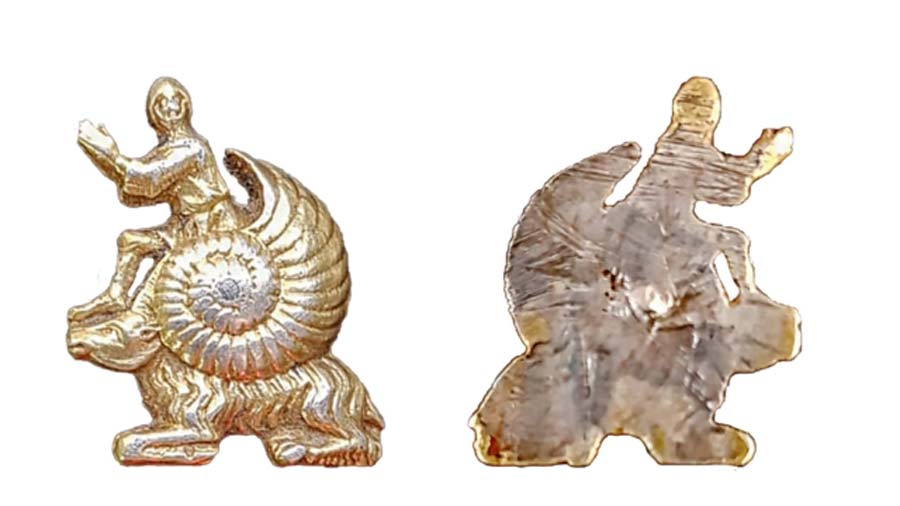The 'Medieval Meme’ That Has Britain Excited
A silver badge which is described as the medieval equivalent of today’s popular meme phenomenon is one of the thousand or so antiquities that has been discovered by metal-detectorists in the UK over the last 12 months of lockdown loot hunting.
The silver gilt piece of ornate and bemusing artistry was found in a field near Pontifract, West Yorkshire, England, the British Museum announced. The Guardian reports that Beverly Nenk, a curator at the Museum described it as, “such a funny little thing” noting its rareness, exclaiming, “I haven’t seen anything like it.”
Snail Man Badge
The “snail man” badge or brooch, is a smidge over 2cm long (a few hairs short of an inch) and is dated to between 1200 to 1350 AD. It shows a man, or more specifically, what looks to be a praying knight, emerging somehow from a snail shell. Oh, and the snail is atop a goat. If it sounds a bit odd, that’s because it is. Medieval badges were usually far more obvious representations of people, places or events.
- Sir Gawain and the Green Knight’s Beheading Game
- The Knights Hospitallers: Courageous Crusaders of Many Names, Homes, and Roles
So can the meaning of the medieval meme be deciphered? Well, the BBC says it is thought the piece has ‘religious connotations’, and that snails were associated with cowardice during this period. The BBC quotes Nenk:
"Snails are often depicted in the margins of medieval illuminated decorated manuscripts and are thought to symbolise cowardice, and this may be the intended meaning."
The strange combination – a praying knight emerging from a snail on a goat - is thought likely to be satirical. Ms Nenk notes it could be a ‘parody of the upper classes’ or recording an act of “non-chivalric behaviour of opponents in battle”.
Is it a Medieval Meme?
Today we think of memes as video clips or photos tagged with amusing text that arrive in our media stream to make us think or laugh, and are often a form of satire themselves.
The definition of a ‘meme’ may be modern – Richard Dawkins first used it in his 1976 book The Selfish Gene, notes the BBC article, writing that they are “ideas that spread from brain to brain”. This surely opens up the whole symbolism of history to memedom. Examples such as this badge take it back to the Middle Ages, but of course such a concept has existed through the ages.
Without words to add some context to the image, the experts are left scratching their heads, and your guess is as good as theirs as to what the imagery meant to the owner of the piece. So, any suggestions?
- Satire in Mesopotamia: Unravelling the Bull Headed Lyre of Ur
- When Hannibal Met His Nemesis: The Battle of Zama
More Lockdown Loot
Whilst you are working that one out, there are more finds to marvel at.
1077 finds that have been recorded by the Portable Antiquities Scheme in 2020, a reduction on the previous year, but there are still some very interesting finds amongst them.
One neat find included a mirror handle and a pair of tweezers, part of a grooming kit from the Iron Age (800 BC – 100 AD), found in Kensworth in Bedfordshire, thought to be around 2000 years old.

An iron age mirror handle and a pair of tweezers was another 2020 find. (The British Museum)
Although finds were a little low last year, with restricted movement no doubt affecting the number of finds, those still buried treasures won’t be going far, and the detectorists will be keener than ever to get out to search those fields, hills and dales, to reveal more of the story of the UK’s past.

A copper alloy Roman furniture fitting with the face of the god Oceanus (British Museum)
Note, the UK’s Treasure Act of 1996 requires that anyone who finds an artifact over 300 years old must report it to the authorities in that area. If the object is deemed to be a treasure, it is taken to the British Museum to be valued, and the discoverer is paid a fair market price for it.
Top image: The medieval silver gilt ‘snail man’ badge found last year in West Yorkshire, UK. Source: Yorkshire Archaeology Advisory Service
By Gary Manners

















